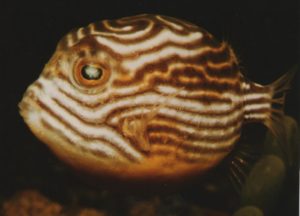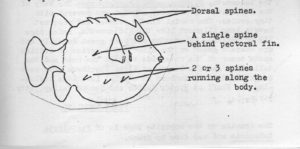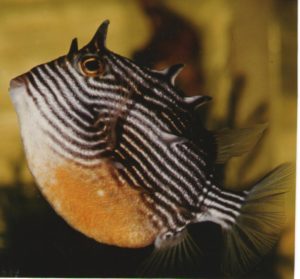In our July 1987 newsletter (No.120), I wrote about the spines of cowfish. I reported having found several small cowfish, both Ornate and Shaw’s. Some were so small that they didn’t have any spines at all. A 2cm-diameter and a 2.5cm Ornate Cowfish did not have any spines at all. Another one, which was just over 3cm-diameter, had just started to grow some spines. They were still tiny and difficult to see though. The two spines above its eyes were the largest of all of its spines. A 4.5cm-diameter one had spines which were quite obvious, though not as big as those to be seen on larger specimens.
A juvenile cowfish before growth of spines
(Photographer unknown)
I went on to state that, according to “The Marine and Freshwater Fishes of South Australia”, both Ornate and Shaw’s cowfish have six stout spines on their back, two of them being above the eyes. Both have similar spines on their sides. Ornate Cowfish are said to have “three or four” on their sides whilst Shaw’s Cowfish are said to have “two to four” spines on each side. Illustrations in “The Marine and Freshwater Fishes of South Australia” show a single spine behind the pectoral fin on each side. The other spines on the side are shown running along the body, below the pectoral fins. It is also interesting to note that the illustrations also show males (both Ornate and Shaw’s) as having three spines running along the side below the pectoral fins, whereas the females of both species are shown as having only two spine there. However, a close look at a large female revealed that it had three spines running along its body below the pectoral fins.
A diagram of an Ornate Cowfish, showing the body spines visible from one side
It is said that all juvenile Ornate Cowfish start out as females, and that some will later turn into males. I mentioned Evan John’s article titled “The Ornate Cowfish” published in our Journal (MARIA Journal Vol.1, No.5, September 1980). In that article, Evan wrote “Juvenile Aracana ornate (Ornate Cowfish) tend to show the orange belly colouring of the (adult) female. It has been observed that animals which become adult females have longer dorsal spines than those which become adult males; the spines on the juvenile “males” are shorter and more obtuse. However, adult females have been observed, for no apparent reason, gradually adopting the male colouration when there are no males present in a tank (aquarium) of females. Interestingly enough, this change can be stopped, and regression to female colouring occurs, if a male cowfish is placed in a tank with changing “females”.”
Close-up of a female Ornate Cowfish
(Photographer unknown)
The changing of sex from female to male is known as Protogyny. A protogynous fish is one that has started off as a female capable of producing eggs, but is able become a male capable of producing sperm. (The changing of sex from male to female is known as Protandry. A protandrous fish is one that has started off as a male capable of producing sperm, but is able become a female capable of producing eggs.)
This drawing of a male Ornate Cowfish featured on the front cover of our December 1990 newsletter :-
A male Ornate Cowfish
(Artist unknown)
(The header drawing was done by Josie Kau)





